
26 minute read
More Power
from 2022-05-TEC
Energy-Efficient Ideas for Big Impacts
By Claudia Cooper
In 2019, 1.4 million North Carolinians lived with unaffordable energy bills. Rural households, in particular, spend a greater portion of their income on energy — about 40% more — than do households in metropolitan areas. These higher energy burdens have been associated with a range of negative outcomes, such as poorer health and comfort, due in part to older, inefficient structures and equipment.
At Advanced Energy, we’ve been working for more than four decades to make homes not only more energy efficient and comfortable, but also healthier, safer, more durable and environmentally responsible. To achieve this, we’ve built relationships with electric cooperatives across North Carolina that have allowed us to collaborate to best serve their members. As a recent example, last year, we received a grant from the Coronavirus Aid, Relief and Economic Security (CARES) Act. One of the projects we pursued was to provide efficiency upgrades to heating and cooling systems in homes with historically high utility bills. Several of North Carolina’s electric cooperatives helped us find qualified participants in eight of our state’s most economically distressed counties.
Ultimately, we were able to replace heating and cooling systems in 41 residences to help reduce occupants’ energy burden and enhance their comfort. These homes are predicted to save more than $30,000 combined annually.
In addition to supporting projects that upgrade inefficient and outdated equipment in people’s homes, we partner with North Carolina’s electric cooperatives to provide
education resources that their members can use to make changes themselves. Examples of these resources include our Advanced Energy at Home program; Carolina Country’s home improvement “On the House” column (see page 20); and a newly launched service called Ask an Expert so cooperative members and others can connect more directly with energy specialists. Promoting energy efficiency and comfort We are proud to work in homes — both in cooperative territories and throughout the state — is a critical and with North Carolina’s never-ending task, and it’s one way we carry out electric cooperatives to our mission of providing economic, environmental and societal benefits through innovative help better the lives of and practical approaches to energy issues. We are proud to work with North Carolina’s electric their members every day. cooperatives to help better the lives of their members every day. If you want to get started on some low- and no-cost energy efficiency measures today, consider changing out old lightbulbs for LEDs, washing clothes and dishes only when loads are full, turning off or unplugging appliances and electronics when not in use, and setting your thermostat to “Auto” so the equipment’s fan runs solely when it needs to. Reach out to your electric co-op if you have any questions about energy efficiency, and learn more about Advanced Energy at advancedenergy.org.
Claudia Cooper is an account manager for the Raleigh-based nonprofit energy consulting firm Advanced Energy.
May Quick Hits
Treats for Mom Show the mothers in your life some love on Mother’s Day, May 8. Find a gift-worthy dessert recipe at carolinacountry.com/ recipes.
Safe Electricity
Keep your home’s electrical system in good repair. Contact a licensed electrician if you have flickering lights, sparks, non-functioning outlets, or need wiring repairs or upgrades.
Dealing with ants? Before purchasing a toxic ant killer, consider natural though effective alternatives such as boric acid powder.
Springtime Storms
When thunder roars, go indoors. Lightning can strike as far as 25 miles away from its parent thunderstorm.
NC Co-ops Take the Stage at National annual Meeting
In March, leaders from North Carolina’s electric cooperatives joined more than 5,000 peers from around the country in Nashville for the 2022 PowerXchange, the annual meeting of the National Rural Electric Cooperative Association (NRECA), the trade association of America’s electric cooperatives.
NRECA CEO Jim Matheson greeted attendees with a message lauding electric cooperatives’ reputation and accomplishments, as well as their aspiration to move their communities forward.
“That’s what I respect most about the work you do,” Matheson told co-op leaders at the March 7 general session. “And it’s my motivation to keep improving — to keep searching for ways we can be better.”
Matheson noted that electric co-ops are viewed as a trusted source by Republicans and Democrats on Capitol Hill about where their communities stand. He outlined four co-op values he highlights when meeting with policymakers: ■ Co-ops strengthen communities through innovation and member support. ■ Co-ops provide essential services where no one else will.
■ Co-ops provide reliable service from a resilient system. ■ Co-ops accelerate the advancement of technology in rural America. North Carolina’s electric cooperatives were represented on the agenda for the 2022 Next Generation Leaders Experience and TechAdvantage, both held in conjunction with the annual meeting.
Michael Trent, director of Innovative Energy Solutions for Randolph EMC, served on a panel discussing emerging industry trends as part of the program for the Next Generation Leaders Experience. The program is designed to help emerging co-op leaders attending PowerXchange build their knowledge of the cooperative network.
Don Bowman, vice president of Engineering and Operations for Wake Electric, served on a TechAdvantage panel on reevaluating electric meter lifespans — a seemingly simple question that can have wide-ranging implications for future strategic planning.
John Lemire, director of Grid Management for North Carolina’s Electric Cooperatives, also presented at TechAdvantage on microgrid architecture, design considerations, project implementation and real-world results with lessons learned.
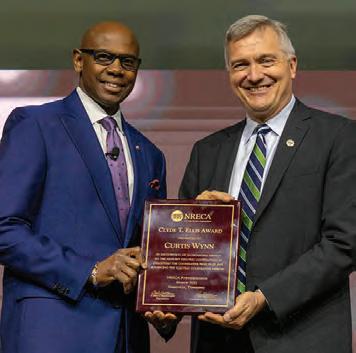
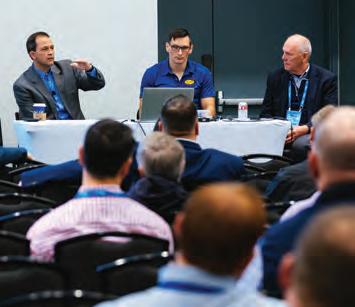
Above, top: NRECA CEO Jim Matheson (right) presented Curtis Wynn, former CEO of Roanoke Electric Cooperative and former NRECA board president, with the Clyde T. Ellis Award. The award, named for NRECA’s first CEO, honors those who have made exemplary contributions that promote the progress of rural electrification and the development and use of natural resources. Above, bottom: Wake Electric’s Don Bowman (left) presented as part of a TechAdvantage panel discussion.
Support Available for Homeowner Assistance
Funds offered for financial hardships due to COVID-19
The pandemic affected North Carolinians in so many ways, including leaving some with financial hardships due to factors like job losses, reduced work hours or the loss of family providers. For those struggling with housing related costs as a result of the pandemic, funds are available through the NC Homeowner Assistance Fund. The fund was established through the American Rescue Plan of 2021 to help prevent mortgage delinquencies, defaults, displacements and foreclosures due to COVID-19, and is managed by the North Carolina Housing Finance Agency.
For those who qualify, the fund offers housing payment assistance; assistance for mortgage reinstatement to catch up on late payments or other housing-related costs due to a period of forbearance, delinquency or default; and assistance covering other housing-related costs to prevent foreclosure.
Assistance of up to $40,000 is available for qualified homeowners as long as funding is available, and there is no cost required to participate. Visit nchaf.gov or call 1-855-MY-NCHAF to see if you or a loved one is eligible and apply.
Halifax EMC’s utility-scale solar + storage project is the first of its kind to be deployed by North Carolina’s electric cooperatives.

Solar, Battery Projects Lead U.S. Planned Capacity
From 2022 to 2023, electric utilities plan to add 85 gigawatts (GW) of new generation capacity to the U.S. power grid. Sixty percent (51 GW) will be made up of solar power and battery storage projects, according to the U.S. Energy Information Administration (EIA). In many cases, projects combine these technologies.
Enfield-based Halifax EMC recently partnered with the North Carolina Electric Membership Corporation to pair solar power with battery storage.
“Solar energy is most abundant during the middle of the day, but demand peaks in the late afternoon hours in the summer and early in the morning during winter,” said Jimmy Wilkins, vice president of Portfolio and Resource Optimization for North Carolina’s Electric Cooperatives. “With this [solar + storage] project, we are capturing a renewable resource when it’s most abundant, storing it and discharging it exactly when it’s needed — there’s a lot of potential here.” (See “Halifax EMC Solar + Storage Project Marks NC Milestone,” September 2021, page 8.)
Of the total planned U.S. capacity, utility-scale solar accounts for 41 GW. New battery storage capacity, which can help make power grids more resilient and reliable, accounts for 10 GW. In North Carolina, electric cooperatives are deploying utility scale batteries at 10 sites around the state to provide 40 MW of power (see “Electric Co-ops To Deploy Batteries Across Rural NC,” March 2022, page 6).
The remainder of planned U.S. capacity additions over the next two years will largely come from natural gas (16 GW) and wind (15 GW).
“The amount of planned wind capacity dropped by nearly half from the previous two years, which had 29 GW of new wind capacity come online,” EIA said.
Renewables
on the roof

By Scott Gates | Photos by Randy Berger Photography
Electric co-ops are helping members make sound solar power decisions
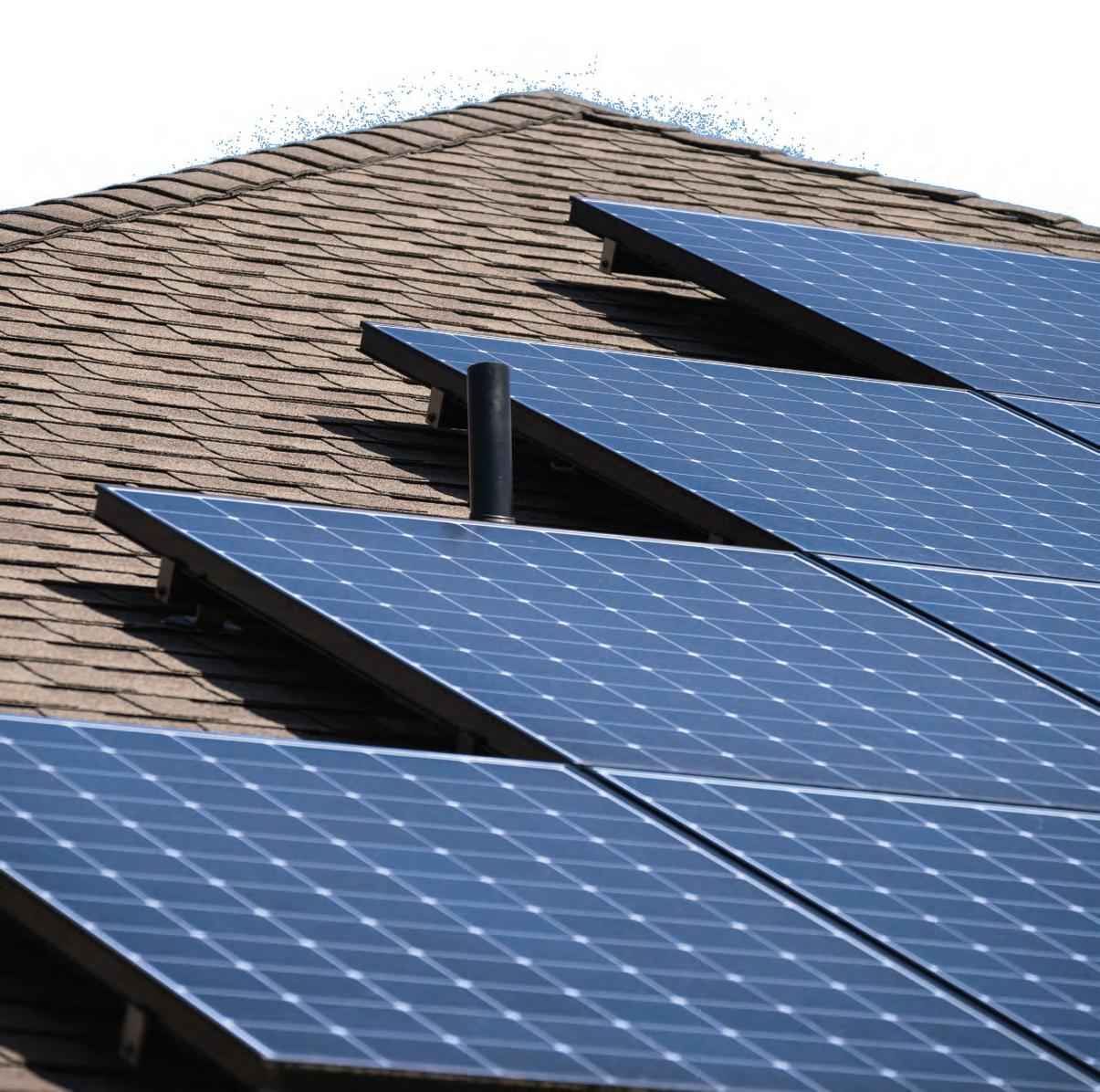
For most North Carolina homeowners, a roof, in itself, is a substantial investment. Shingles, roofing materials and labor all add up, as anyone who’s had to have a roof replaced can tell you.
A little over three years ago, retired Army helicopter pilot David Page, a member of Dunn-based South River EMC, started looking at his roof with a different kind of investment in mind: solar power. A federal rebate and a desire to lower his monthly electric bill spurred initial online searches of local solar companies.
But as he quickly discovered, rooftop solar is a major investment, and doing research — including working with his electric co-op — was going to be key to making a sound decision.
“I said to my wife, ‘You know what? Maybe I need to call South River to find out what’s involved,’” he remembers.
South River EMC Energy Services Adviser Robbie Talton — one of the of the co-op’s “Advise Guys” — discussed solar as an option with Page based on his goals and his overall home energy use. Armed with the right information, Page then met with four local solar companies and went with the one that “wasn’t interested in pushing financing.”
With the federal tax credit, Page expects the system will pay for itself over the course of 11 to 13 years. With that length of payoff, however, he doesn’t see it as something for a typical homeowner.
“Look at it as an investment. A lot of solar companies push that the electric bill is going to go down, but take that with a grain of salt,” he says, explaining that some companies exaggerated potential savings. “People just need to do research and keep an open mind.”

Solar in the spotlight
These days, it’s hard to avoid commercials from residential solar companies touting the benefits of the renewable energy resource. The main reasons behind the solar buzz are declining costs and improved technology, as well as increased public interest in renewable energy.
Solar photovoltaic (PV) panels, which are made of materials that convert sunlight into electrical energy, have made huge strides in efficiency and affordability over the decades. Research and development has enabled the cost of large, utility scale solar to decrease from an average $4.75 per watt (DC) in 2010, to less than a dollar a watt (DC) in 2020, according to data from the National Renewable Energy Lab. Residential solar prices benefited as well during that period, with a steady decline in both soft costs, like installation labor, and hardware costs, like panels and inverters. (Supply chain issues and general increases in construction labor costs in recent years may lead to an uptick in average costs, although 2021 data was unavailable at the time of publication.)
North Carolina has seen an annual increase in the number of installed residential solar systems since 2016, hitting a peak in 2020 when 5,717 homeowners installed new systems, according to the latest data from the NC Sustainable Energy Association (see chart).
South River EMC Energy Services Adviser Robbie Talton (right) checks out David Page’s solar installation.

$8
$7
$6
$5
$4
$3
$2
$1
Average Installed Residential PV System Cost
7.53
6.62
4.67
4.09
3.60 3.36 3.16 2.94 2.78 2.77 2.71 Annual NC Residential Solar PV Installations
5,717
3,275 3,729
365 457 877 1,472
1,106 1,225 8,000
7,000
6,000
5,000
4,000
3,000
2,000
1,000
Number of Systems
Solar panels on the roof of South River EMC member Craig Wilson’s home

That growth is scattered across the state, although urban areas and surrounding counties are seeing more concentration. Jake Thomas, manager of Marketing & Energy Services for Monroe-based Union Power Cooperative, which serves counties in the Charlotte region, said he noticed interest in solar increased during the pandemic.
“We live in such a busy world — with everyone slowing down during the pandemic, it allowed more time for people to do some research,” he says. “Our solar inquiries and requests continue to grow.”
Homeowner considerations
For those considering solar power for their home, the message is clear: due diligence is critical. That starts with taking time to think through personal home energy goals and whether solar power is the most effective way to meet them.
“Solar energy is a really enticing enhancement for many people, but it is definitely not for everyone,” says Catherine O’Dell, vice president of Member Services and Public Relations with South River EMC. “We encourage members to call their cooperative and speak to an energy expert, check out resources like PV Watts (pvwatts.nrel.gov) for an accurate estimate of solar output, and perform a payback analysis in order to make an informed decision.”
Other basic factors to consider include: ■ How is your home using energy? If saving on electric bills is a priority, explore other, lower-cost ways to do so first. Proper insulation and updated HVAC systems, including smart thermostats, can lead to notable savings.
“In many cases, the money that a member would spend on solar can be invested in the home and make a much bigger and more consistent impact on energy costs with less investment,” O’Dell explains.
Another factor to consider is that homes with solar systems remain connected to the grid to ensure consumers experience reliable electric service, even when the sun is not shining — contrary to claims exaggerated by some solar companies that solar power facilitates home energy independence. ■ Is your roof suitable for solar? A shaded roof with 20-year-old shingles, for example, wouldn’t make for a sound solar investment. Removing solar panels for a roof replacement adds costs, a definite consideration if a roof would need replacing in five to 10 years. South or west-facing roof slopes are optimal for solar, although solar companies can provide a more detailed analysis of a specific property.
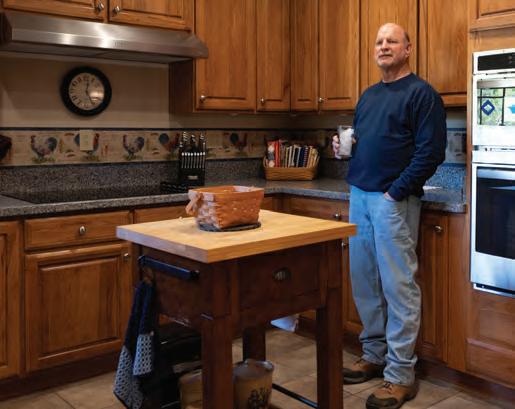
■ Do the financials work for you? Reach out to several solar companies for quotes. Make sure cost estimates include the total cost for getting the system up and running, including hardware, installation, connection to the grid, permitting, sales tax and warranty. Work with your electric co-op to estimate a payoff period — the time it will take for the energy saved to cover the cost of the system — with the understanding that if you plan to move within that period, it’s not a guarantee costs will be recouped. Also, understand the eligibility requirements of any available incentives, such as the federal solar tax credit.
A personal energy adviser
As David Page discovered early in his solar journey, working with your electric cooperative upfront can go far in making a sound decision. Your electric co-op can help assess your home’s energy use and make sure you have all the relevant data to make sense of quotes from solar companies.
“We want to equip our members to lead conversations with vendors, as opposed to solar companies leading those conversations,” Union Power’s Jake Thomas says. “We’re not going to make a decision for our members, but it’s our job as their energy partner to ensure we put all the relevant information on the table. We don’t want there to be any surprises.”
In addition to the electric cooperatives quoted, Burgaw-based Four County EMC contributed to this article.
Scott Gates is the senior editor of Carolina Country.
Regarding solar panels, Page says, “People just need to do research and keep an open mind.”

Country Folk Art
The need to create is a North Carolina tradition

By Leah Chester-Davis
Folk art dealer Matt Ledbetter, of Gibsonville, talks nonstop about the folk art that surrounds him. He launches into a story about his latest folk art find, large totems that have been intricately carved by Greensboro artist Carl “Otto” Long. The totems create a forest-like gathering in Matt’s warehouse. Likely from cypress wood, they are painted different colors and stand anywhere from three- to 10-feet tall with intricate detail and symbolism.
By the time Matt met Otto, the self-taught, visionary artist had been creating totems and walking sticks for more than 30 years, although, according to Matt, he had not received the attention or acclaim that he deserved. Matt had hoped to work with Otto in the coming years to get his work into the collections of folk art enthusiasts but, sadly, Otto passed away in November 2021, just before his work was to be featured in one of the quarterly events at Ledbetter Folk Art Auctions.
Otto was just one part of a long North Carolina tradition of folk art, outsider art, visionary and selftaught art, curated and celebrated by organizations around the state.
Ledbetter Folk Art Auctions
Matt serves as auctioneer at his auction house in Gibsonville (ledbetterauctions.com), and clearly relishes discovering unknown folk artists and building relationships with them. Whenever he interacts with artists, he works to capture their stories and inspiration, often documenting with photographs and videos. He defines folk art as “art from necessity.”
When it comes to what is considered folk art, a wide range of materials and media are used. Ledbetter Folk Art Auctions featured several pieces by African American artist Arbon Lane in a recent auction. Matt says that one piece, an elaborate, detailed colorful painting of the Black Christ child is “one of the best Arbon Lane paintings.” A collector in Germany purchased it for a friend in Charlotte.
Arbon was a self-taught Reidsville native who died in 2005. Even in his hometown, his life as an artist was little known, according to Margaret Day Allen, author of “When the Spirit Speaks: Self-Taught Art of the South.”
Arbon was a prolific artist, and used house paint on materials that were readily available and free or inexpensive, Margaret wrote in an article for the Folk Art Society of America (folkart.org). That included pieces of wood and roofing tin. Many creations of numerous artists transform plain, everyday items into something original.
The Folk Art Center
On a crisp November day, Katherine Caldwell is weaving straws of wheat into an intricate pattern that is taking shape as a candy cane. Katherine is one of two artisans who is demonstrating their craft that day in the lobby of The Folk Art Center in Asheville (southernhighlandguild.org) — home to the oldest craft shop in the United States. The center cultivates and showcases the crafts and makers of the Southern Highlands Craft Guild.
“Wheat weaving is as old as agriculture,” Katherine says. Whether it’s wheat or another grain, the woven

Matt Ledbetter Matt Ledbetter (left)

Matt Ledbetter

ANNUAL FOOTHILLS
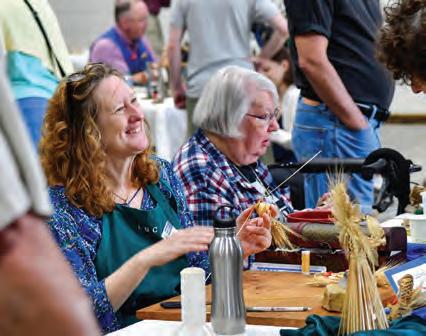
Southern Highland Craft Guild

patterns that have been passed down for centuries were used in rituals and hung in houses after the harvest. “The intricate designs would keep the spirit of the grain safe for the coming spring.”
Katherine integrates those timehonored techniques into her creations, helping preserve the ancient tradition. Among her creations is a spiral wheat cross and several other cross designs, ornaments, hair barrettes and Earth Mothers.
“Every culture in history has some type of Earth Mother, and this is my interpretation,” she says.
A wide range of handcrafted art from current artisans is on display and for sale at the Folk Art Center. In its exhibits section, works from both current and past artisans point to a wide range of materials and inspiration. Black Mountain artist David Taylor’s work is in collections nationwide — his “Dog in Door,” a metal sculpture that uses a recycled car door, is on display at the Folk Art Center. Other works on display are miniature turkeys made about 1930 from pinecones and tree bark by Asheville artisan William Perry Smith (1910–1977).
Folk Art Festival
May 14, Newton foothillsfolkartfestival.com
For a taste of folk art for your family, the Downtown Newton Development Association and Hickory Museum of Art will hold the Annual Foothills Folk Art Festival on May 14, 2022. The event showcases a variety of local and regional contemporary folk artists whose work will be for sale. It will also include artist demos, hands-on art activities for children, live music, food from area restaurants and food truck vendors, beer gardens, and more.
John C. Campbell Folk School
Perhaps one of the most well-known venues to encourage fine and folk art and craft in many expressions is the John C. Campbell Folk School in Brasstown (folkschool.org). Founded in 1925, the school celebrates the many art forms of the Appalachian region.
Visit for the day and see the works of more than 300 local and regional artists, or participate in one of the many classes, concerts, or other events offered. (For more information, read “Secrets of the Mountains,” from our October 2018 issue, page 10).
Katherine Caldwell
Vollis Simpson Whirligig Park
Vollis Simpson, of Lucama, created massive whirligigs from salvaged metal and ended up garnering national acclaim before his death in 2013. You can see 30 of his creations, which come alive in the wind, at a public park named for him in Wilson (wilsonwhirligigpark.org). In 2013, his work was designated as the official folk art of the State of North Carolina.
Whether creating massive outdoor contraptions, painted found objects or pieces of pottery, it seems every artist has a story, and part of that story is the need to create — to add to the rich folk art tradition of our state.
As Matt Ledbetter puts it: “Art begets art.”
Carolina Country Contributing Editor Leah Chester-Davis oves to explore North Carolina. Chester-Davis Communications (chester-davis.com) specializes in food, farm and lifestyle brands and organizations.
e world’s lightest and most portable mobility device
Once in a lifetime, a product comes along that truly moves people. Introducing the future of battery-powered personal transportation . . . The Zinger.


Throughout the ages, there have been many important advances in mobility. Canes, walkers, rollators, and scooters were created to help people with mobility issues get around and retain their independence. Lately, however, there haven’t been any new improvements to these existing products or developments in this field. Until now. Recently, an innovative design engineer who’s developed one of the world’s most popular products created a completely new breakthrough . . . a personal electric vehicle. It’s called the Zinger, and there is nothing out there quite like it.

–Kent C., California
The first thing you’ll notice about the Zinger is its unique look. It doesn’t look like a scooter. Its sleek, lightweight yet durable frame is made with aircraft grade aluminum. It weighs only 47.2 lbs but can handle a passenger that’s up to 275 lbs! It features one-touch folding and unfolding – when folded it can be wheeled around like a suitcase and fits easily into a backseat or trunk. Then, there are the steering levers. They enable the Zinger to move forward, backward, turn on a dime and even pull right up to a table or desk. With its compact yet powerful motor it can go up to 6 miles an hour and its rechargeable battery can go up to 8 miles on a single charge. With its low center of gravity and inflatable tires it can handle rugged terrain and is virtually tip-proof. Think about it, you can take your Zinger almost anywhere, so you don’t have to let mobility issues rule your life.
Why take our word for it. You can try the Zinger out for yourself with our exclusive home trial. Call now, and find out how you can try out a Zinger of your very own.
Available in Green, Black (shown) and Blue
e Zinger folds to a mere 10 inches.
Now available in a Joystick model
(Zoomer Chair)
Joystick can be mounted on the right or left side for rider’s comfort
Zinger Chair®
Call now and receive a utility basket absolutely FREE with your order. 1-888-627-5576
Please mention code 116842 when ordering.
Things You Should Consider Before Getting a New Pet

A new pet requires more than a desire to make a new friend
By Rue Reynold
Welcoming a new pet into your life is always an exciting venture, but are you prepared for the responsibility that comes with a new life? Not all pet guides are created equal, so whether you’re looking to welcome a fluffy puppy or admire an elegant tropical fish, here are the steps you should take before and after adding a pet to your family.

Considerations Before getting a new pet, you should consider the lifespan of the animal, the size it will become, the chemistry between your family or any other pets you may have and if you’re ready to invest beyond “minimum” requirements.
Research Popular pet guides are not as reliable as they seem. The “recommended” enclosure size from a pet store is often not the size a reptile, fish, rabbit or other animal needs to thrive. Do your research on the diet, habitat and common health issues associated with your pet before you consider getting one. Don’t rely solely on pet store guides or employees.
Plan and save Once you have an idea of your animal’s needs, it’s time to save money. (Don’t forget a vet fund and monthly pet budget.)
Prepare It’s important to prepare a space for your animal beforehand so that it can feel safe and comfortable sooner. This is especially crucial for aquatic animals that should not be placed in new enclosures right away. Their tanks need to cycle and settle after the nitrogen and ammonia process first. Visit and examine If possible, try to visit your intended pet before committing to it. This way, you’ll get to know its personality, explore chemistry, and get an idea if this animal will get along with any other pets you may have. This is also a chance to examine if the animal is in good health.
Precautions After getting your new companion, it’s crucial to take them to a vet. Regardless of getting them from a pet store, breeder or shelter, you’ll want to make sure your new pet is in tip-top condition. Remember, a bit of knowledge from the start gives you a chance to see if there are any underlying issues with your new friend and prevents possible endangerment to any other pets you may have.
Build Trust Being in a brand-new environment can initially be overwhelming and scary for your new pet. Start slow and let trust build naturally. Provide the animal with your clothing to get them used to your scent. Also, for more timid animals, try to take them out once a day at first. Let them come to you. Beginning a journey with a new companion at your side can be a rollercoaster ride, but with these tips, you and your new pet will have the best possible start.
Make Family Reunions Meaningful
Plan ahead to make the most of conversations

For many, reunions that had been postponed during the pandemic are finally starting to take place. Once those long-awaited hugs have been exchanged, everyone can settle in for some overdue catching up.
Sitting down with loved ones to talk about their lives can be richly satisfying. Learning about memorable events, favorite activities and valuable lessons they have learned can help bring you closer and get to know them in a different way. Consider the following tips from RememberingALife.com to begin these meaningful conversations.
Start by sharing mutual stories. If you’ve taken a vacation together or shared a cherished experience, discuss that first to get the conversation going. If your family member is hesitant, share your own stories first so he or she feels more comfortable.
Take notes. Either during or after your conversation, make note of the important memories shared.
Ask questions. One of the easiest ways to start and maintain a conversation is by asking questions. A visual prompt like a photo album, souvenir or memento can also be a conversation starter.
Treat your talk as a beginning. Use it as a springboard for more conversations which you can openly talk about any number of things, from reflecting on the past to planning for the future.
When the time comes, make it meaningful. These shared conversations may help your family plan a meaningful funeral or life tribute for your loved one that honors his or her life. When the time comes, memorialization can be an important step in the journey toward healing.
—FamilyFeatures.com
Love Carolina Country? Don’t miss an issue!
Subscribe and get Carolina Country in your mailbox every month for just $1 an issue!
Co-op Members, check with your electric cooperative to find out if they offer complimentary subscriptions as a benefit of membership.
Yes! Please start my subscription.
NAME
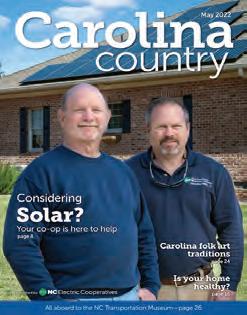
MAILING ADDRESS
CITY STATE ZIP
PHONE NUMBER (If we have questions)
1 Year (12 issues) $12 2 Years (24 issues) $24 Check Enclosed
R eal People. Real Power.

Annual meeting
Tideland EMC’s Annual Meeting of Members will be held on Thursday, May 12, at Beaufort County Community College, Building 8. Member registration begins at 6:30 p.m., with the business meeting to follow at 7:00 p.m.
The evening will include prize drawings, a complimentary gift for the first 100 registered members and a grand prize of a $500 electric bill credit. We hope to see you there.
Classroom
innovation
K-12 classroom teachers have until Sept. 15 to submit Bright Ideas grant applications. Teachers who apply by Monday, Aug. 15 are eligible for a statewide early bird prize drawing. Approximately 600 grants are awarded annually by NC’s Electric Cooperatives. Locally, Tideland’s funding limit is $2,000 per project.







